Abstract
Multiple pharmacologic interventions are detrimental to children due to the anti-health effects they can exert including influencing and disrupting delicate microbiotal symbiosis. This case outlines a lifetime dependence on antibiotics, steroids, and ventolin in a five-year-old Australian boy reversed after treatment with classical homeopathy, in accordance with ‘direction of cure’ theory.
Classical homeopathy may be considered as a potential therapeutic modality in chronic recurrent pathologies, and controlled studies are required to establish the extent to which it may decrease reliance upon pharmacological treatments and associated costs.
Keywords
Pneumonia, insomnia, facial tics, homeopathic therapy, case report.
Introduction
Autism spectrum disorder (ASD) is defined as a lifelong condition which impairs an individual’s social skills and autonomy, having the core features of persisting deficits of social communication and interaction, restricted and repetitive behaviours, interests, and activities, usually appearing before 3 years of age. ‘Spectrum’ describes varied symptomatology ranging from high functioning to extremely afflicted individuals who require lifelong support and care1.
Compounded by neurodevelopmental, psychiatric, and somatic comorbidities2, 3 ASD causation is complex and mostly genetic, with the Deleted-In-Autism-1 (DIA1) gene aetiologically implicated4. Although ASD epigenetic mechanisms are not yet fully understood, genome-wide alterations and dysregulation5 point to lowered DNA methylation6 and subsequent inactivation of X chromosomes in the frontal lobe, temporal cortex, cerebellum, and prefrontal cortex regions of the brain7.
Worldwide, rates of ASD are rising sharply. In Australia ASD increases faster than any other disability8 with 205,200 people diagnosed in 2018 – a 25% increase from 20159. Northern Ireland ASD prevalence has quadrupled in a decade with rates in eleven – to thirteen-year-old children now 1 in 1710.
Cat Eye (Schmid-Fraccaro) Syndrome (CES) is a rare genetic syndrome caused by a partial tetrasomy of chromosome 22. With an incidence of 1 in 150 00011 it manifests as multiple malformations involving the eyes, ears, cardiac, anorectal, and urogenital systems12, with congenital heart defects present in half of CES individuals13.
Congenital heart defects are the most common of all birth defects, with rates of 1 in 150. A patent ductus arteriosus (PDA), with overall incidence of 2-3 per 1000, is a common congenital heart defect13.
Pneumonia is a leading cause of morbidity and mortality in the developing world in children under five years of age. In the developed world the burden of disease is substantial with significant healthcare-associated costs14.
Children with recurrent pneumonia often have cardiopulmonary comorbidities15. Tanoue & Oda16 found correlation between ASD incidence and recurrent bouts of pneumonia and bronchiolitis. Sleep disturbance and deprivation, particularly insomnia, is common and often associated with daytime behavioural problems in children with ASD, and increased levels of parental stress17.
Tics, often a feature in ASD18, resemble normal movements which occur repetitively with exaggerated intensity and increased frequency. Gilles de la Tourette syndrome is the most prevalent primary tic disorder19.
Case report
Harry, a five-year-old Australian boy living with his parents, brother and sister, and dog.
Initial consultation
16th April 2018, Western Australia.
Main complaint
Recurrent pneumonia, with insomnia, and facial tics.
Table 1: Medical History, Harry
| Diagnosis | Intervention |
| Asphyxia during birth by emergency caesarean section. | Ventilation. |
| Patent Ductus Arteriosus. | Patent Ductus Arteriosus surgery at six months of age. |
| Cat Eye Syndrome with cryptorchidism, and preauricular pits. | Four surgeries from eight months of age to locate Left test-icle – lodged in Left lung. |
| Recurrent ear, nose and throat (ENT) inflammation. | Twenty+ courses of antibiotics prior to tonsillectomy and adenoidectomy, with insertion of grommets at two years’ old. |
| Recurrent pneumonia. | Multiple courses of antibiotics, prednisolone, ventolin from 18months’ – present. |
| ‘Up to date’ with the Western Australian Immunisation schedule. | |
| Anaphylaxis – peanuts. | |
| Autism Spectrum Disorder. | Diagnosed at three years old, speech pathology and occupational therapy sessions implemented immediately. |
| Insomnia. | Coincided with starting school. Melatonin prescribed (to no effect). |
Table 2: Family Medical History, Harry
| Mother | Ondansetron (zofran zydis) prescribed to control severe first trimester nausea and vomiting. Ondansetron is contraindicated in pregnancy20 as it is implicated in a host of birth defects21 and congenital malformations22, 23, including cardiac.(24) |
| Maternal Line | Cardiovascular, respiratory complaints. |
| Paternal Line | Dementia, migraine, scoliosis, cardiovascular complaints.
Leukaemia – grandmother. |
Table 3: Presenting symptoms, Harry, April 2018.
| Mental / Emotional | Physical | General |
| Loves to, and constantly tidies the yard.3.
|
Pneumonia, repeated winter bouts 2 with rapid lethargy, copious and clear mucous which induces vomiting 2, cough on waking 2, speaking while coughing 2. | Insomnia – from 4am.3.
|
| Loves dancing, music must be playing all the time.3. | Eczema backs of knees.1.
|
Loves watermelon, bananas, chocolate milk,
fruit juice.3. |
| Facial tics – wiping and blinking eyes < attention at school.3. | Warts left knee.1. | |
| Loves babies and little kids obsessively, paying them hyper attention.3. | Gags after ingesting too much food.1. | |
| Predicting events usually around his dog i.e., glass on footpath, dog attack etc.2. | ||
| Approaches and chats with strangers.2. | ||
| Anxiety with pneumonia.2. | ||
| Pinches when angry.1.
Prefers not to hug.1. Extraordinary memory.1. Friends with everyone at school.1. Anxious in a crowd.1. |
Table 3 The numbers 1-4 denote intensity of symptom – 4 extreme; 3 strong; 2 moderate; 1 mild.
Analysis
Harry had undergone seven surgeries by age two. Anaesthetics, antibiotics, vaccinations, and steroids, exerting their strong physiological effect over the organism, can result in immune dysfunction. Harry’s frequent acute infections combined with chromosomal abnormalities is indicative of the sixth Level of Health (Fig.1) where infections typically require medical assistance as they are more severe due to the comorbidities already in existence at this level25.

Figure 1: Ladder of Health by Vithoulkas. Adapted from ‘scale of the Levels of Health, from level 1 to level 12, divided into four groups A, B, C, and D. The healthiest level is at the top. This illustration depicts the genetic predisposition of the individual and the degree of strength of their defence mechanism29.
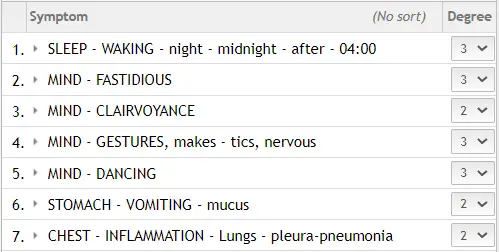
Figure 2: Repertorisation of symptoms (Table 3), April 2018. Vithoulkas Compass (2022)
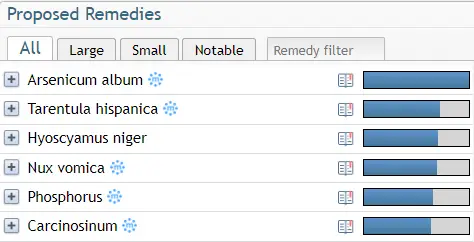
Figure 3: Results based on repertorization (Fig. 2), April 2018. Vithoulkas Compass (2022)
Differentiation of remedies
CARCINOSINUM. An important characteristic in Carcinosinum children is SLEEPLESSNESS. WAKING AT 4AM and cannot fall asleep again – which started alongside NERVOUS TICS of the eyes, and eyelids shortly after starting school, ties the possibility of FEAR THAT THEY WILL NOT BE ACCEPTED as a prime and underlying cause for Harry’s behaviours and AN INHERENT NEED TO ESTABLISH ORDER becoming FASTIDIOUS, TIDY, INDUSTRIOUS, with A STRONG SENSE OF ORDER – Harry with his love of tidying the yards every morning may also suggest a HIGH SENSE OF RESPONSIBILTY.
LOVE OF DANCING, and sensitivity to music. May be great lovers of animals – empathetic and sympathetic elements combine to a sense of clairvoyance. Fear of busy streets (in a crowd), and an aversion to consolation (hugs). Lack of reaction i.e., absence of fever. Tendency to develop ASTHMATIC CONDITIONS is seen in Harry’s requirement for predmix and ventolin during CHRONIC PNEUMONIA26.
PHOSPHOROUS. Children are warm, friendly, outgoing, musical, and sensitive with a typical craving for chocolate and sweets27 and exhibit extreme sympathy – can become involved with strangers – the phosphorous child makes contact with anyone. Clairvoyance. Anxiety about health. Recurring respiratory infections. Pneumonia28.
Prescription, April 2018
CARCINOSINUM 200c, once daily for three days’ only. In Group B (Fig.1) the dose can be repeated for a few days29.
Response to the remedy, May 2018
Harry was very angry, emotional, and weepy, with increased tiredness and lethargy for one week after Carcinosinum. Initial reactions to the remedy can be very strong in Group B with temporarily heightened emotions, weakness, and need for sleep. Indicative of a good immune response where there is functional pathology but also sometimes in deeper pathologies too. This reaction gives a good prognosis29.
Table 4: Improved, worsened and new symptoms, May 2018
| Improved symptoms | Worsened symptoms | New symptoms |
| Waking at 0530 or 0600 full of ideas and energy for jobs. | Health anxiety i.e., after throwing ice at his brother who bled. | Sneezing 7am with a thick, clear nasal coryza. |
| Trip to a cooler climate did not result in pneumonia. | Many questions about death i.e., pet dog who died four years ago. | |
| Clearer thought processes and conversation with increased emotive language noted by occupational therapist. |
Prescription, May 2018
Nil.
Table 5: Improved, worsened and new symptoms, Harry, June 2018
| Improved symptoms | Worsened symptoms | New symptoms |
| Waking at 0630. | Obsessed with others if they’re sick or hurt. | Unsettled and energetic every night 1730-1830. |
| Nil pneumonia or respiratory issues. | Sneezing 7am with a thick, clear nasal coryza. | |
| Marked decrease in facial tics even when attention is directly on him. | Drinking large amounts of cold chocolate milk on waking. | |
| Less obsession with babies. | ||
| Less obsession with dancing and music which is still always playing. | ||
| Improved communication. | . | |
| Nil sixth sense incidents. |
Response to the remedy, June 2018
After an initial aggravation in April, Harry remained well for some months after Carcinosinum indicating restoration of immune function had begun29.
Prescription, June 2018
Nil.
Appointment, Harry, March 2022
Harry is almost ten years old and has developed symptoms which require attention, including a fever of 39.8°C which is an excellent sign his immune system has become more robust29, 31 and is now capable of raising a fever in response to an infectious pathogen25, 30.
As all diseases – acute and chronic – in the entire medical history of a person form links in the chain of immune response, the reappearance here of old symptoms, first present when Harry initially developed pneumonia as a toddler, show the direction of cure (progression of symptoms appearing in the reverse order in which they came during recovery from serious illness31, 32) is correct, which is also evidenced by no recurrence of pneumonia or need for steroids, ventolin or antibiotics since March 2018.
Table 6: Presenting symptoms, March 2022.
| Mental / Emotional | Physical | General |
| Anxious and angry ‘why
have I got this.’ 1. |
Cough with retching, gagging 2 and vomiting thick 2, yellow 3, stringy mucous since 3am 3. | Lethargy 1 with 39.8C fever 1.
|
Table 6 The numbers 1-4 denote intensity of symptom – 4 extreme; 3 strong; 2 moderate; 1 mild.
Figure 4: Repertorization of symptoms (Table 6), Harry, March 2022. Vithoulkas Compass (2022)

Figure 5: Results based on repertorization (Fig. 4), Harry, March 2022. Vithoulkas Compass (2022)

Differentiation of remedies
KALI BICHROMATUM typically manifests physical pathology, especially effecting the mucous membranes of the respiratory tract producing excessive, thick, yellow, stringy discharges28.
HYDRASTIS CANADENSIS can be easily confused with Kali bichromatum with its thick, ropy discharges of the respiratory tract, and can affect all mucous membranes28.
Kali carbonicum, with its tendency to pneumonia in children, and modality of general aggravation from 2 to 4am, and Pulsatilla with its copious ear, nose and throat discharges, were both differentiated but not selected as neither remedy strongly features the tendency to stringy mucous28.
Prescription, March 2022
KALI BICHROMATUM 30C – One dose immediately, and again before bed.
Ideally a 1M (not in my dispensary) would have been prescribed in alignment with the sixth Level of Health29, which is why two doses were suggested.
Response to the remedy, 27 March 2022
After two doses of Kali bichromatum 30C, Harry woke unsettled that night at 3am without coughing, vomiting, retching, or mucous and was asleep again by 3:30am, ate a big breakfast, and did not cough the next day.
Update, 02 April 2022
The entire household has been quite unwell all week with respiratory illness, Harry however is ‘good as gold,’ and the family are all very relieved.
Discussion
Homeopathic theory proposes that the aggressive use of drugs in the treatment of superficial inflammation overwhelms the immune system32, impeding the body’s natural curative responses and allowing the disease process, now in the form of chronic low-grade inflammation29, access to vital to life body and organ systems where it can manifest as chronic disease25, 34. The evolution of Harry’s recurrent infections (Table 1) is in alignment with this theory.
Peacefully balanced microbial symbiosis determines the degree of overall health status 35 – 37. Microbiome science substantiates the fundamental principles of homeopathy33 and provides the novel addition to Level of Health theory29 that the levels (Fig. 1) are determined primarily, but not exclusively, by eubiotic or dysbiotic microorganisms predominantly populating the digestive tract, but also the skin25, and any exposed surface or mucous membrane, such as the vagina, lungs, mouth, nose, sinuses, ears, nails, or eyes.
Paediatric cohorts suffer most commonly from microbiologically destructive events, with exponentially increasing rates of chronic systemic inflammatory disease38. In Australia the highest rate of dispensed antibiotics in under 65’s is for children aged two and four, most commonly in otitis media39.
The return of Harry’s original onset pneumonia symptoms (Table 6) is reflective of direction of cure theory – old, suppressed conditions return as the general chronic condition improves – evidenced by no recurrence of pneumonia or need for steroids, ventolin or antibiotics for four years, since March 2018, indicating favourable progression and prognosis38, 40.
References
1 DSM-5. 2013. Diagnostic and Statistical Manual of Mental Disorders. 5th Edition. Washington, DC: American Psychiatric Association.
2 Pan PY, Tammimies K, Bölte S. 2020. The Association Between Somatic Health, Autism Spectrum Disorder, and Autistic Traits. Behavioural Genetics [online]. Jul;50(4):233-246. Available from: https://www.ncbi.nlm.nih.gov/pmc/articles/PMC7355269/
3 Hirvikoski T, Mittendorfer-Rutz E, Boman M, Larsson H, Lichtenstein P, Bölte S. 2016. Premature mortality in autism spectrum disorder. The British Journal of Psychiatry: the journal of mental science [online]. Mar;2083:232-8. Available from: https://pubmed.ncbi.nlm.nih.gov/26541693/
4 Aziz A, Harrop SP, Bishop NE. 2011. DIA1R is an X-linked gene related to Deleted In Autism-1. PLoS One [online]. Jan 17;61:e14534. Available from: https://pubmed.ncbi.nlm.nih.gov/21264219/
5 Melnyk S, Fuchs GJ, Schulz E, Lopez M, Kahler SG, Fussell JJ, Bellando J, Pavliv O, Rose S, Seidel L, Gaylor DW, James SJ. 2012. Metabolic imbalance associated with methylation dysregulation and oxidative damage in children with autism. Journal of Autism and Developmental Disorders [online]. Mar;423:367-77. Available from: https://pubmed.ncbi.nlm.nih.gov/21519954/
6 Hu VW. 2013. The expanding genomic landscape of autism: discovering the ‘forest’ beyond the ‘trees’. Future Neurology [online]. Jan 1;81:29-42. Available from: https://pubmed.ncbi.nlm.nih.gov/23637569/
7 Forsberg SL, Ilieva M, Maria Michel T. 2018. Epigenetics and cerebral organoids: promising directions in autism spectrum disorders. Translational Psychiatry [online]. Jan 10;81:14. Available from: https://www.nature.com/articles/s41398-017-0062-x
8 The Australian Autism Alliance. 2020. A Snapshot of Autism in Australia – Prevalence and Incidence [online]. Available from: https://australianautismalliance.org.au/autism-snapshot-2/
9 Australian Bureau of Statistics. 2019. Disability, Ageing and Carers, Australia: Summary of Findings [online]. Available from: https://www.abs.gov.au/statistics/health/disability/disability-ageing-and-carers-australia-summary-findings/latest-release#autism-in-australia
10 Rodgers and McCluney. 2022. Prevalence of Autism (including Asperger Syndrome) in School Age Children in Northern Ireland. Community Information Branch Information & Analysis Directorate Department of Health. Belfast, Northern Ireland [online]. Available from: https://www.health-ni.gov.uk/sites/default/files/publications/health/asd-children-ni-2022.pdf
11 Sharma D, Murki S, Pratap T, Vasikarla M. 2014. Cat eye syndrome. BMJ Case Reports [online]. May 19;2014:bcr2014203923. Available from: https://www.ncbi.nlm.nih.gov/pmc/articles/PMC4039909/
12 Berends MJ, Tan-Sindhunata G, Leegte B, van Essen AJ. 2001. Phenotypic variability of Cat-Eye syndrome. Genetic Counseling (Geneva, Switzerland) [online]. 121:23-34. Available from: https://pubmed.ncbi.nlm.nih.gov/11332976/
13 McDermid, 2021. Cat Eye Syndrome. NORD National Organisation for Rare Disorders, Inc. Quincy, Massachusetts [online]. Available from: https://rarediseases.org/rare-diseases/cat-eye-syndrome/
14 Ebeledike C, Ahmad T. 2022. Pediatric Pneumonia. [Updated 2022 May 8]. In: StatPearls [online]. Treasure Island, Florida: StatPearls Publishing. Available from: https://www.ncbi.nlm.nih.gov/books/NBK536940/
15 Nandan D, Mittal H, Sharma A, Srivastava K. 2021. Thinking beyond infections in children with recurrent/persistent pneumonia. Tropical Doctor [online]. 2021 Jul;513:356-361. Available from: https://pubmed.ncbi.nlm.nih.gov/33736546/
16 Tanoue Y, Oda S. 1989. Weaning time of children with infantile autism. Journal of Autism and Developmental Disorders [online]. Sep;193:425-34. Available from: https://pubmed.ncbi.nlm.nih.gov/2793787/
17 Johnson KP, Zarrinnegar P. 2021. Autism Spectrum Disorder and Sleep. Child and Adolescent Psychiatric Clinics of North America [online]. Jan;301:195-208. Available from: https://pubmed.ncbi.nlm.nih.gov/33223062/
18 Baron-Cohen S, Scahill VL, Izaguirre J, Hornsey H, Robertson MM. 1999. The prevalence of Gilles de la Tourette syndrome in children and adolescents with autism: a large scale study. Psychological Medicine [online]. Sep;29(5):1151-9. Available from: https://pubmed.ncbi.nlm.nih.gov/10576307/
19 Kahl U, Schunke O, Schöttle D, David N, Brandt V, Bäumer T, Roessner V, Münchau A, Ganos C. 2015. Tic Phenomenology and Tic Awareness in Adults With Autism. Movement Disorders Clinical Practice [online]. Mar 30;23:237-242. Available from: https://www.ncbi.nlm.nih.gov/pmc/articles/PMC6178731/
20 NPS(MedicineWise), 2018. Consumer medicine information Zofran Zydis Wafers Ondansetron [online]. Surrey Hills, Sydney. Available from: https://www.nps.org.au/medicine-finder/zofran-zydis-wafers
21 Anderka M, Mitchell AA, Louik C, Werler MM, Hernández-Diaz S, Rasmussen SA; 2011. National Birth Defects Prevention Study. Medications used to treat nausea and vomiting of pregnancy and the risk of selected birth defects. Birth Defects Research Part A Clinical and Molecular Teratology [online]. Jan;941:22-30. Available from: https://pubmed.ncbi.nlm.nih.gov/22102545/
22 Lavecchia M, Chari R, Campbell S, Ross S. 2018. Ondansetron in Pregnancy and the Risk of Congenital Malformations: A Systematic Review. Journal of Obstetrics and Gynaecology Canada: JOGC [online]. Jul;40(7):910-918. Available from: https://www.jogc.com/article/S1701-2163(17)30757-0/fulltext
23 Lavecchia M, Chari R, Ross S. 2019. Gaining Insight Into Ondansetron Safety in Early Pregnancy. Journal of Obstetrics and Gynaecology Canada: JOGC [online]. Apr;41(4):419-420. Available from: https://www.jogc.com/article/S1701-2163(19)30005-2/fulltext
24 Damkier P, Kaplan YC, Shechtman S, Diav-Citrin O, Cassina M, Weber-Schoendorfer C. 2021. Ondansetron in pregnancy revisited: Assessment and pregnancy labelling by the European Medicines Agency (EMA) & Pharmacovigilance Risk Assessment Committee (PRAC). Basic & Clinical Pharmacology & Toxicology [online]. Apr;128(4):579-582. Available from: https://pubmed.ncbi.nlm.nih.gov/33275828/
25 Vithoulkas G. 2021. An integrated perspective on transmutation of acute inflammation into chronic and the role of the microbiome. Journal of Medicine and Life [online]. Nov-Dec;14(6):740-747. Available from: https://www.ncbi.nlm.nih.gov/pmc/articles/PMC8811668/
26 Vithoulkas, G. 1997. Materia Medica Viva: Volume 7 (3rd Edition 2012). Alonissos, Greece, International Academy of Classical Homeopathy.
27 Vithoulkas, G. 2012. Essence of Materia Medica. Fourteenth impression. New Delhi. B. Jain Publishers (P) LTD. (Originally published in 1988).
28 Morrison, R. 1993. Desktop Guide to Keynotes and Confirmatory Symptoms. Grass Valley. Hahnemann Clinic Publishing.
29 Vithoulkas, G. 2017. Levels of Health, The second volume of the Science of Homeopathy, revised edition. Alonissos: International Academy of Classical Homeopathy.
30 Sullivan JE, Farrar HC. 2011. Section on Clinical Pharmacology and Therapeutics; Committee on Drugs Fever and antipyretic use in children. Pediatrics [online]. Mar;1273:580-7. Available from: https://pubmed.ncbi.nlm.nih.gov/21357332/
31 Kivellos S, Skifti S, Vithoulkas G. 2014. EHMTI-0396. Reappearance of high fever on migraine patients, after individualized homeopathic treatment, is a valuable prognostic factor. The Journal of Headache and Pain [online]. 2014;15(S1). Available from:https://thejournalofheadacheandpain.biomedcentral.com/articles/10.1186/1129-2377-15-S1-M7
32 Vithoulkas G, Carlino S. 2010. The “continuum” of a unified theory of diseases. Medical Science Monitor [online]. Feb;162:SR7-15. Available from: https://pubmed.ncbi.nlm.nih.gov/20110932/
33 Whitmont RD. 2020. The Human Microbiome, Conventional Medicine, and Homeopathy. Homeopathy [online]. Nov;109(4):248-255. Available from: https://pubmed.ncbi.nlm.nih.gov/32408372/
34 Marra F, Lynd L, Coombes M, Richardson K, Legal M, Fitzgerald JM, Marra CA. 2006. Does antibiotic exposure during infancy lead to development of asthma?: a systematic review and metaanalysis. Chest [online]. Mar;1293:610-8. Available from: https://journal.chestnet.org/article/S0012-3692(15)52261-7/fulltext
35 Schroeder & Bäckhed, 2016. Signals from the gut microbiota to distant organs in physiology and disease. Nat Med. Oct;22(10):1079-1089. Available from https://pubmed.ncbi.nlm.nih.gov/27711063/
36 Cho & Blaser, 2012. The human microbiome: at the interface of health and disease. Nat Rev Genet. Mar 13;13(4):260-70. Available from https://pubmed.ncbi.nlm.nih.gov/22411464/
37 Bisgaard et al., 2011. Reduced diversity of the intestinal microbiota during infancy is associated with increased risk of allergic disease at school age. J Allergy Clin Immunol. Sep;1283:646-52.e1-5. Available from https://pubmed.ncbi.nlm.nih.gov/21782228/
38 Mahesh S, Jaggi L, Jaggi A, Tsintzas D, Vithoulkas G. 2019. Individualised Homeopathic Therapy in ANCA Negative Rapidly Progressive Necrotising Crescentic Glomerulonephritis with Severe Renal Insufficiency – A Case Report. Journal of Medicine and Life [online]. Available from: https://www.ncbi.nlm.nih.gov/pmc/articles/PMC6527409/
39 AURA, 2019. https://www.safetyandquality.gov.au/publications-and-resources/resource-library/aura-2019-third-australian-report-antimicrobial-use-and-resistance-human-health
40 Chabanov D, Tsintzas D, Vithoulkas G. 2018. Levels of Health Theory With the Example of a Case of Juvenile Rheumatoid Arthritis. Journal of Evidence-Based Integrative Medicine [online]. Jan-Dec;23:2515690X18777995. Available from: https://www.ncbi.nlm.nih.gov/pmc/articles/PMC6024340/




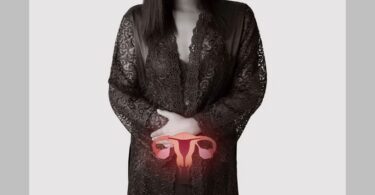
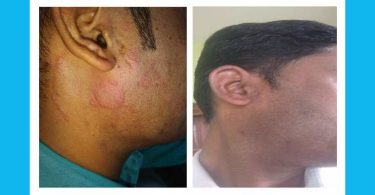
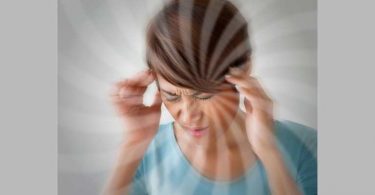
Thanks Sarah, I enjoyed reading this article.
Great to hear Gabrielle!
Thank you for your feedback!
Sarah